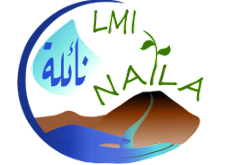Aims to continue the advances made during NAÏLA 1, namely to describe the “social-economic-agro-hydrological” elements by characterizing their diversities, their geometries, their functional properties and their interlocking organizations, all essential information for studying the functioning (axis 2) and developments (axis 3). The work carried out addresses several scientific obstacles relating to the specificities of Mediterranean environments, in particular spatial heterogeneity and discontinuities. Their purpose is to study (1) the physical environment (e.g., climate, soil substrate), (2) anthropogenic developments (e.g., agricultural plots), and (3) anthropogenic organizations (e.g., cropping systems).
“Surface hydrodynamic properties” sub-axis
In a semi-arid context, the characterization of surface hydrodynamic properties in connection with agricultural practices and plant cover is a major challenge, particularly through the consequences on soil infiltrability. On the one hand, we will design plot-scale monitoring using non-traditional methods adapted to crop cycles. The potential of Sentinel-2 and Sentinel-1 satellite data will be explored for the multi-temporal characterization of physical parameters associated with ad hoc control factors such as texture, crop residue cover rate, type of tillage, the presence of weeds, humidity. On the other hand, we will characterize the spatial distribution of shrinkage slots from high spatial resolution photographic coverage, to then analyze the explanatory mechanisms of the presence and activity of shrinkage slots through predictive modeling.
“Hydro-structural properties” sub-axis
We study the spatial variability of the hydro-structural properties of soils using geophysical methods. Compared to traditional intrusive methods, geophysical soundings are spatially more integrating, non-destructive and easier to implement, thereby allowing continuous specialization of the critical zone representing the sphere of water exchanges along the continuum “Under ‐ soil /soil /plant /atmosphere”. The geophysical surveys will allow us to establish for each study site a structural model (2D, 3D) of the geological and/or soil formations, which will serve as a basis for the description of their hydrodynamic functioning in axis 2.
“Climate forcing” sub-axis
The activities are a continuation of those conducted during NAÏLA 1, but improving existing methodological developments, while exploring new avenues. The main objective remains the same, namely to provide past and future chronicles at fine spatio-temporal resolution for standard meteorological variables, by combining statistical methods and data sets from sparse meteorological networks. The major added value will lie in the exploration of new statistical methods, including the design and implementation of a spatial stochastic generator of weather conditions with inclusion of constraints. To a lesser extent, we will characterize climate dynamics and variability through the description of trends, ruptures and extreme events (precipitation, droughts), by analyzing spatio-temporal series by dedicated statistical methods (e.g., Small test, method Bayesian theory of Lee and Heghinian).
"Agrosystems" sub-axis
The issues here are a continuation of the work of NAILA 1. The objective is to develop robust methods for mapping land cover based on the Sentinel-2, Spot (4.5 and 6) and Landsat, combined with possible acquisitions by drone, taking into account the strong inter-class and inter-annual heterogeneity.
In terms of the characterization of agricultural practices, it is a question of consolidating previous studies with the supply of elements to study the functioning in axis 2 and formalize the trajectories in axis 3. Via a time series of occupation of the soil, we will characterize elements related to cropping patterns/rotations and agricultural practices (e.g., ploughing) at farm level.
“3D structures” sub-axis
This part describes works centered on elements that require three-dimensional descriptions. This work concerns topography to improve the understanding of surface flow, and forestry due to the structural complexity of the canopy.
